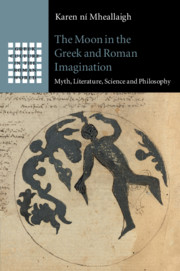Book contents
- The Moon in the Greek and Roman Imagination
- Greek Culture in the Roman World
- The Moon in the Greek and Roman Imagination
- Copyright page
- Dedication
- Contents
- Acknowledgements
- Abbreviations, Text References and Translations
- Part I The Moon in the Mythic Imagination
- Part II The Moon in the Scientific Imagination
- Chapter 2 Making Sense of the Moon
- Chapter 3 Life on the Moon
- Chapter 4 The Moon of Many Faces
- Part III The Moon in the Fantastic Imagination
- Bibliography
- Index
- Index Locorum
Chapter 4 - The Moon of Many Faces
Plutarch’s Great Lunar Dialogue De Facie
from Part II - The Moon in the Scientific Imagination
Published online by Cambridge University Press: 09 October 2020
- The Moon in the Greek and Roman Imagination
- Greek Culture in the Roman World
- The Moon in the Greek and Roman Imagination
- Copyright page
- Dedication
- Contents
- Acknowledgements
- Abbreviations, Text References and Translations
- Part I The Moon in the Mythic Imagination
- Part II The Moon in the Scientific Imagination
- Chapter 2 Making Sense of the Moon
- Chapter 3 Life on the Moon
- Chapter 4 The Moon of Many Faces
- Part III The Moon in the Fantastic Imagination
- Bibliography
- Index
- Index Locorum
Summary
Plutarch’s dialogue On the face of the Moon, known more conveniently by its abbreviated Latin title De facie, is the only work dedicated exclusively to the Moon to have survived from antiquity. It therefore marks a landmark in the history of selenography: a nodal point in ancient thinking about the Moon as well as (as I shall argue) between ancient and modern lunar thought. The dialogue is rooted in curiosity about the dark blotches on the lunar surface. Cultures across the world have long discerned human or animal features in the appearance of the lunar disc. Common lunar pareidolia include: a trio of a man, tree and dragon or individual figures such as a rabbit. Demetrius Triclinius, the author of a Byzantine treatise on the Moon, who certainly knew Plutarch’s De facie, provides a detailed description of the figure of a lunar man, as we shall see. But the characters of Plutarch’s dialogue saw a human face in the Moon, in a tradition that links the ancient world with the modern.
- Type
- Chapter
- Information
- The Moon in the Greek and Roman ImaginationMyth, Literature, Science and Philosophy, pp. 146 - 202Publisher: Cambridge University PressPrint publication year: 2020



